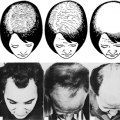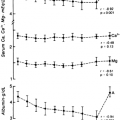PROCALCITONIN AND ITS DERIVATIVE PEPTIDES
The CALC-I gene encodes the information for the structure of the polypeptide precursor of CT, preprocalcitonin (Pre-ProCT). Early in posttranslational processing, the leader sequence is cleaved from this precursor molecule by a signal peptidase. The resultant prohormone, procalcitonin (ProCT, also termed PAN116), consists of 116 amino-acid residues (molecular mass 12.79 kDa) (see Fig. 53-3).The function of ProCT, which is present at low levels in normal human serum (<5 pg/mL; <0.4 fmol/mL),46 is unknown; an immunomodulatory role has been postulated.
At the amino-terminus portion of ProCT is found a 57-amino-acid peptide, NProCT (also termed PAS-57), which has a molecular mass of 6.22 kDa. NProCT, which is readily detectable in normal human serum (10–70 pg/mL; 1.6–12 fmol/mL), has no known definite function, although it has been reported to be a mitogen for osteoclasts.46,47 The immature CT is centrally placed within the ProCT molecule. This peptide, which also is present in normal serum, has no known function other than as a precursor of mature CT. The final 21-amino-acid residues comprise CCP-I (also termed PDN-21 and previously called katacalcin). As shown in Figure 53-1, the CALC-I gene can also produce a CCP-II peptide arising from a different form of CT mRNA. CCP-I, which differs from CCP-II in its eight terminal amino acids, occurs predominantly in thyroidal C cells and neuroendocrine malignancies such as MTC tissue, and also in the serum of normal persons, whereas CCP-II, which has been insufficiently studied, is found mostly in the pituitary and in neurologic tissues.48 Although these peptides may have a biologic function, none has yet been proven. Lastly, as part of the processing of the ProCT molecule, a peptide consisting of the conjoined immature CT and CCP-I peptide (CT:CCP-I) occurs in normal serum, where its function, if any, is unknown.46
All of the peptides that contain the CT molecule in its immature form (i.e., ProCT, CT:CCP-I, and immature CT) cross-react with antisera specific for the midportion of the immature CT molecule and, along with NProCT, have been termed CT precursors (CTpr), precalcitonin peptides, or large-molecular-weight CT.
Regulated versus Constitutive Secretion.
The extent of posttranslational processing of ProCT largely depends on whether the prohormone is secreted mainly by a regulated pathway, as in the thyroidal C cells, or a constitutive pathway.49 In regulated secretion, the Golgi apparatus identifies and selects ProCT to be routed to newly formed secretory vesicles, where the mature CT is produced and progressively concentrated. Subsequently, these electron-dense vesicles serve as storage repositories for later secretion. On the appropriate signal at the plasma membrane, a brief increased concentration of cytosolic free Ca2+ induces secretion (i.e., migration to the cell periphery, fusion with the apical portion of the cell membrane, and discharge of hormone contents in a quantal release). In regulated secretion, in addition to CT, these vesicles also contain and extrude variable concentrations of the other processed products of ProCT (i.e., NProCT and CCP-I). ProCT and CT:CCP-I are largely absent from the storage vesicles.
In contrast, under certain conditions, constitutive secretion occurs, in which less-dense vesicles receive CT precursors, bud off from the trans-Golgi, and migrate rapidly to the cell surface. This nonstoring, continuous secretion of newly synthesized peptide(s) is a bulk-flow system by which hormonal material is rapidly secreted. Because of the lack of processing machinery within these different, rapidly transported and rapidly extruded vesicles, the relative proportion of CT in relation to precursor peptides is considerably diminished. In the case of the ProCT molecule, this form of secretion may occur to a small extent in normal persons, whereas in some pathophysiologic conditions, it is greatly increased (see later). It is uncertain why some tumors (e.g., MTC, small cell lung cancer [SCLC], bronchial carcinoid) secrete relatively small amounts of CT in comparison with large amounts of CTpr despite their abundant number of dense-core secretion vesicles, which are characteristic of regulated secretion.
DISORDERS ASSOCIATED WITH ABERRANT PRODUCTION AND SECRETION OF CALCITONIN PRECURSORS AND DERIVATIVE PEPTIDES
MEDULLARY THYROID CARCINOMA
Although the assay for CT has become the standard marker for the clinical detection and follow-up of MTC, CT precursors and other derivative peptides are also increased in the sera of these patients, frequently to a greater extent than is the CT.50 Furthermore, some of these lesions secrete CGRP and precursor CGRP peptides as well. Nevertheless, the time-honored marker remains mature CT, and care should be taken to use the most specific assay.51
Nearly all MTC patients have increased basal serum CT (see Chap. 40 and Chap. 188), and nearly all patients with MTC respond markedly to a calcium and/or pentagastrin challenge, even when in a “subclinical” stage (i.e., C-cell hyperplasia).
A patient with a thyroid mass and increased basal CT probably has MTC, and this usually can be readily confirmed by a fine-needle aspiration biopsy and immunocytochemical staining. In most sporadic cases of MTC, the basal serum CT level usually has not been obtained preoperatively, and the diagnosis most often is made by examination of the surgical specimen. In this respect, some clinicians believe that a screening basal serum CT level should be measured preoperatively for all nodular thyroid disease.52 Furthermore, preoperative basal CT levels are predictive of the tumor size and offer information concerning the probability of postoperative normalization of the hormone level.53 In those patients proven to have MTC, follow-up CT testing after surgery is essential to detect persistent local disease or to document the presence of metastases; later, long-term follow-up is essential to detect a subsequent recurrence or further tumor growth. In the past, the major use of provocative testing had been for the initial screening of the family members of a patient with MTC to help determine whether the patient had the sporadic or the familial variety of the disease, and also for the screening and follow-up of relatives of known familial cases. Currently, genetic studies (i.e., Ret protooncogene) have largely replaced the use of provocative testing of family members of an index case with known disease for the purpose of determining whether any specific relative is affected. In the future, provocative testing will probably become limited to the follow-up examination of individual nonhypercalcitonemic family members previously shown to possess the genetic abnormality and for whom prophylactic thyroidectomy is not selected (see Chap. 188). The authors’ preference had been to perform a combined calcium and pentagastrin stimulation, because the effect of the latter hormone is additive with that of induced hypercalcemia. Pentagastrin often causes marked epigastric and chest pain, however, and is not an approved drug in the United States. Intravenous stimulation testing of family members is onerous and, for children, frightening. For family members and for patients with diagnosed C-cell hyperplasia whose serum CT has normalized after surgery, the measurement of iCT in a single urine specimen has
proved to be more sensitive than serum measurements. The urine assay readily detects early disease in a family member or recurrent disease in the index case and often obviates the need for stimulation testing.54
proved to be more sensitive than serum measurements. The urine assay readily detects early disease in a family member or recurrent disease in the index case and often obviates the need for stimulation testing.54
Stay updated, free articles. Join our Telegram channel

Full access? Get Clinical Tree





